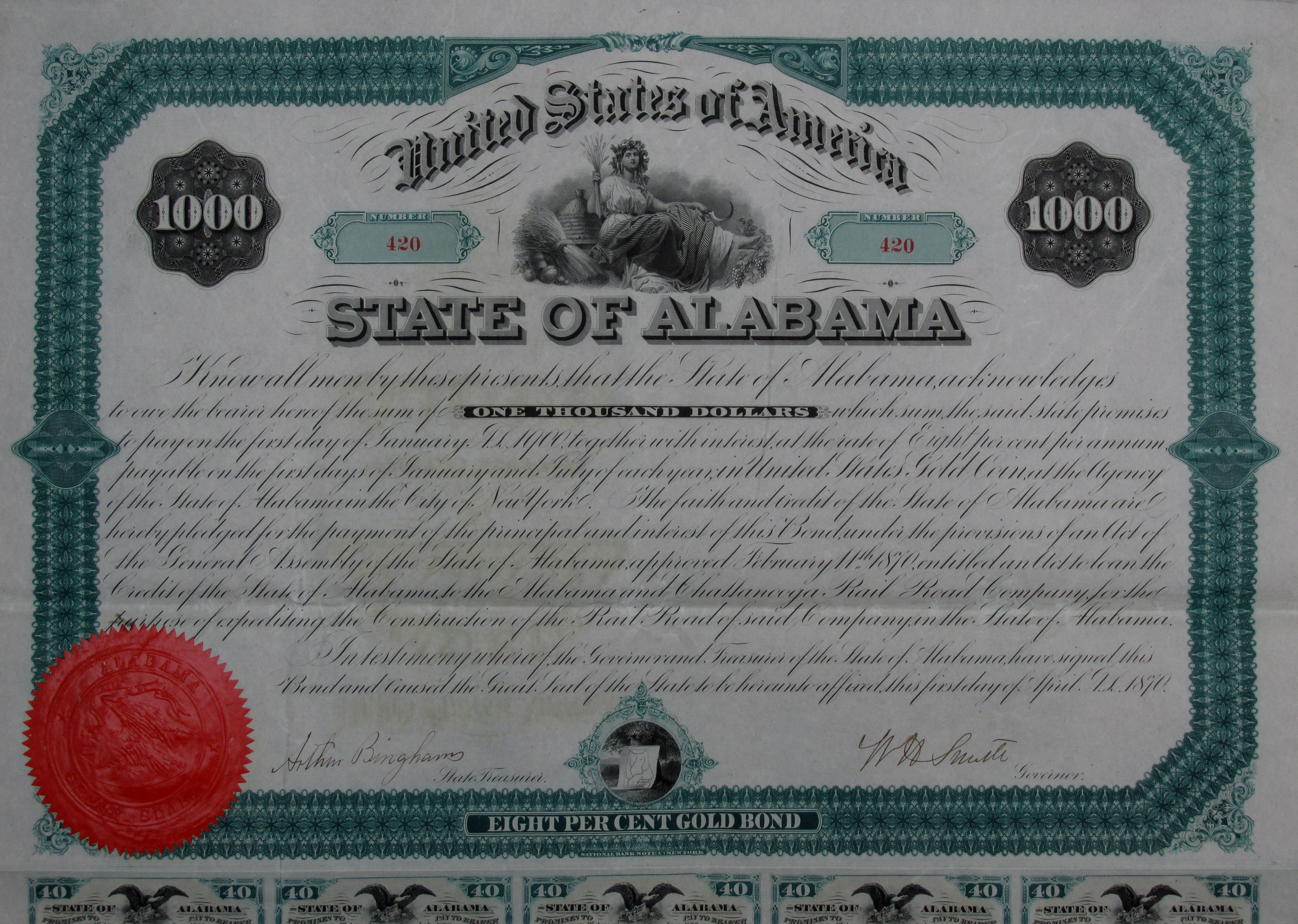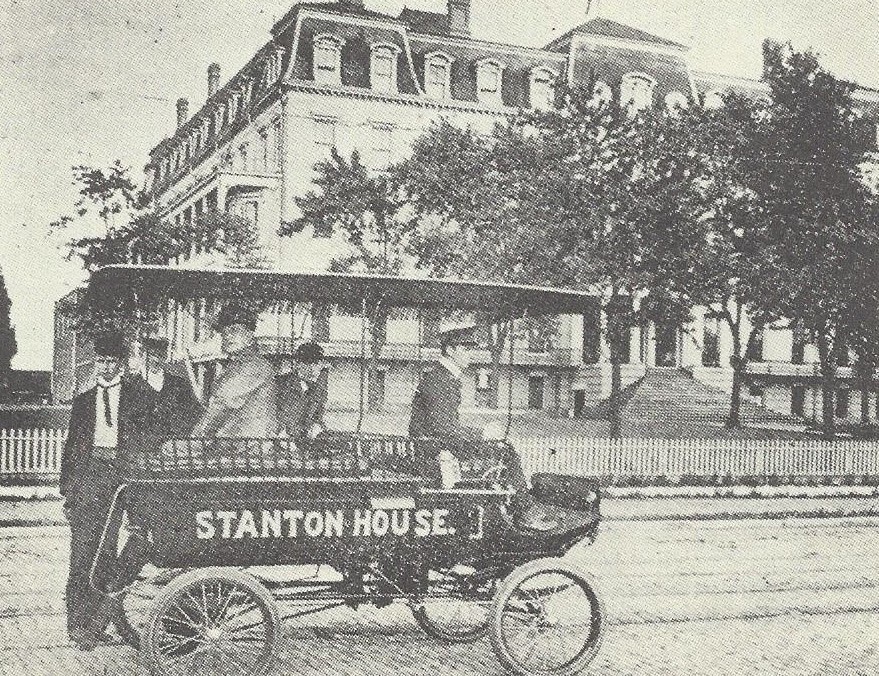by Bill Gunther

“Know all men by these presents that the State of Alabama, acknowledges to owe the bearer hereof the sum of one thousand dollars which sum the said state promises to pay on the first day of January A.D. 1900 together with interest at the rate of eight percent per annum, payable on the first days of January and July of each year in United States gold coin at the Agency of the State of Alabama in the City of New York. The faith and credit of the State of Alabama are hereby pledged for the payment of the principal and interest of this bond under the provisions of an Act of the General Assembly of the State of Alabama, approved February 11, 1870, entitled an Act to loan the Credit of the State of Alabama to the Alabama and Chattanooga Rail Road Company for the purpose of expediting the Construction of the Rail Road of said company in the State of Alabama.”
“In testimony whereof the Governor and Treasurer of the State of Alabama have signed this Bond and Caused the Great Seal of the State to be hereunto affixed this first day of April, A.D.1870”
This 1870 $1,000 bearer bond was issued under an Act of the General Assembly of Alabama to loan the State’s credit to the Alabama and Chattanooga Rail Road to, it was argued, facilitate the completion of the road. The actual passage of the act was accompanied by “the most shameful bribery” of legislators by agents of the rail road and its president, John C. Stanton.1 After initially being rejected by the legislature on February 10, 1871, an amazing “change of heart” occurred and on the next day the legislature authorized the bonds. The Act specified a maximum of $2 million of these “direct” bonds could be issued at the rate of $16,000 per mile of completed rail road when evidence of 5-mile sections were submitted. Initially, the rate of support was set at $11,000 but John C. Stanton was instrumental in having the rate increased to $16,000 per mile.2 Few of the legislative conditions for release of these bonds were met resulting in “nightmarish fiscal difficulties that culminated in the state’s insolvency”.3
A Complicit Administration
The Governor at the time, William Hugh Smith, and the Treasurer, Arthur Bingham, despite their knowledge that legislators had been bribed by agents of the rail road, still signed the bonds. Then, knowing that the intent of the law for these bonds to be issued incrementally, Governor Smith transferred the entire $2 million issue (2,000 bonds) to the rail road and John C. Stanton around March 26, 1870. Stanton then reportedly had these bonds quickly shipped to Europe to be sold.4
A number of legal questions arise with regard to these bonds and the state’s liability. First, since bribery by Stanton and his agents was clearly involved in the passage of this act, could the state legally nullify the issue? A second point, one raised by Smith’s successor, Governor Robert Burns Lindsay who beat Smith in his reelection bid in the fall of 1870, was the fact that the state’s 1867 constitution required a two-thirds vote to provide “credit of the State of Alabama.”5 By this measure, the vote of 62 in favor with 27 against and 11 not voting, the bond issue failed to meet that legal requirement. Finally, the law required evidence of the completion of 5 miles of railroad work for each submission for release of the bonds. No evidence of any road completion was ever located to justify the release of any of these bonds. Unfortunately, these legal questions were all made moot by the fact that, in less than one year from the date of issue of the bonds, the Alabama & Chattanooga Railroad defaulted on their obligation to pay interest to bondholders in January and on June 8, 1871, was declared bankrupt.6
A New Governor Investigages
The election of 1870 was very contentious with the rail road support provided by Smith being a major subject. Smith ran for reelection, but was narrowly defeated by Robert Burns Lindsay. After the election, Governor Smith, as well as Treasurer Bingham, refused to accept the result, claiming fraud in the election, and “barricading” themselves in their officies.7 Actually, Governor Smith was well aware of Lindsay’s intent to investigate the methods and level of support granted to the Alabama and Chattanooga Rail Road and he, and his co-conspirators, were intentionally trying to delay any investigation.
After a three-week delay in his inauguration, Governor Lindsay took the oath of office and shortly thereafter began his investigation into the State’s support of rail roads, especially the Alabama and Chattanooga. Regarding any records of bond issues, he reported to the legislature that he could not find a “scratch of a pen,” apparently because no records were kept or they had been destroyed or were removed from the capital!8 When ask to testify before the House Investigating Committee, Arthur Bingham, the treasurer who countersigned these bonds, claimed the “constitutional privilege of refusing on the grounds that his testimony would tend to incriminate himself.”9 At about the same time (January, 1871), the Alabama and Chattanooga Rail Road defaulted on their payment of interest on the bonds. Apparently, the lack of sufficient cash to pay this interest was the result of the Alabama and Chattanooga redirecting a large portion of the state bonds to build an opera house and luxury hotel, called “Stanton House”, in Chattanooga, Tennessee.
The 5-story “Stanton House” hotel contained 100 guest rooms with restroom facilities on each floor, a first for a multi-story hotel.10 The hotel also contained a public telegraph office and boasted a “horseless carriage for the use of guests”. Room rates were $2.50 to $3 a night and the hotel helped Stanton establish “Stanton Town”, a vibrant business center with multiple shops. The hotel was a very popular stopping place for wealthy travelers on the railroad.

Unfortunately, Stanton’s developments were all based on extensive credit and when the Alabama and Chattanooga railroad failed, “The bankruptcy tore Chattanooga from tower to turret.”11 There were many workers and contractors who continued to work despite not being paid, assured by Stanton that he would soon turn things around. A railroad conductor, N. J. Bell, in his recollections noted that:
“Men who had taken the contracts could not get their money and had to sell their wagons and teams to pay the men who got out ties for them. Some grade contractors never got their money at all.”12
Even Bell noted that he was owed “about ten hundred and sixty some odd dollars, which I had earned at hard work” on the Alabama and Chattanooga Rail Road.13
An indication of the degree of fraud imposed on State with regard to the railroad was the fact that the 1870 law authorizing the issue of these direct bonds specified support was to be at the level of $16,000 per mile of roadway completed. When the values of direct support (these bonds $2,000,000) and the state’s “indorsed” Alabama and Chattanooga bonds ($5,300,000) were added, that State support amounted to just short of $40,000 per mile!14
Financial Impact on the State
The financial obligations with respect to all rail roads imposed a huge burden on the State of Alabama which ultimately led to insolvency. Interest alone on all of the rail road bonded debt in 1874 at 8 percent amounted to “twice the yearly income of the state.”15 Seeing no alternative but to try and restructure this debt, the State created a “Debt Commission” on December 17th of 1874, and charged this commission to “ascertain, adjust and liquidate all claims against the State of Alabama.”16
In a lengthy report issued one year later on January 24, 1876, the Commission recommended a number of steps including refinancing many of the legally endorsed bonds at a lower rate of interest, disavowing some bonds as improperly issued, and in the case of the $2,000,000 in direct support to the Alabama and Chattanooga Rail Road, swapping the State’s mortgage bonds on the Alabama and Chattanooga land for these direct bonds issued by the state.17 Holders of the direct bonds were provided with bonds of equal stated value which were the state’s security against default by the Alabama and Chattanooga Rail Road.
The conversion or swap of bonds was recommended to occur in London or New York, a reflection of the likely concentration of holders of the outstanding bonds. The Commission also recommended that the proposed agreement be advertised “at least four times each year in the London Times newspaper, and one daily newspaper in New York.”18 Bonds submitted after May 1, 1886, “shall have no further claim against the state.”
Surviving Bonds with Coupons
Given the opportunity to swap bonds with dubious value for bonds secured by the rail road’s land and rights-of-way seems like it would be a welcome opportunity, provided the holders were aware of the situation. When submitted the State, the direct bonds and their coupons would be destroyed. We know the state made every effort to inform bond holders of the offer, and one would suspect that individuals who had not received interest payments for a number of years would have made independent inquiries even if they had not seen any of the newspaper advertisements. How then can we explain the survival of uncancelled bonds with attached coupons.?
First, while these bonds found their way to Europe and England, many of them remained in the hands of agents, and were used as collateral (“hypothecated”) for other loans. Hypothecated bonds were pledged, but not released to the lender, and these loans were repaid the bonds remained with the agents, perhaps after the deadline for redemption. A second possibility, and a less likely explanation, is that these bonds were “saved” from destruction by government employees or their agents to serve as souvenirs. Whatever the reason, these bonds remind us of some very difficult financial times in Alabama following the end of the Civil War.
John C. Stanton left Chattanooga, apparently a wealthy man, in 1880 and retired in New York City where he died in 1901 at the age of seventy-six.19
Footnotes
1Walter L. Fleming, Civil War and Reconstruction in Alabama (New York: The Columbia University Press, 1905), p.592.
2John W. DuBose, ed. by James K. Greer, Alabama’s Tragic Decade: Ten Years of Alabama -1865-1874 (Birmingham: Webb Book Company, 1940), p.178.
3Samuel L. Webb and Margaret E. Ambrester, Alabama Governors: A Political History of the State (Tuscaloosa: The University of Alabama Press, 2001), p. 89.
4DuBose, p. 183.
5Fleming, p. 589n.
6DuBose, p. 186.
7Webb and Ambrester, p. 89.
8Fleming, p. 594-595.
9Fleming, p. 601.
10”Stanton House,” https://en.wikipedia.org/wiki/Stanton-House.
11Gary C. Jenkins, “John C. Stanton,” http://tennesseeencyclopedia.net/entry.php?rec=1257.
12James A. Ward, ed. Southern Railroad Man. N. J. Bell’s Recollections of the Civil War Era. (DeKalb: Norther Illinois University Press, 1994), p. 143.
13Ward, p. 147.
14DuBose, p. 186.
15Fleming, p. 583.
16Report of the Commissioners (Debt Commission), January 24, 1876, State of Alabama Senate Journal, 1875-1876, p. 205.
17Report of the Commissioners (Debt Commission), pp. 228-229.
18Report of the Commissioners (Debt Commission), p. 232.
19 Gary C. Jenkins, “John C. Stanton,” www.Tennesseeencyclopedia.net/entry.php?rec-1257.



